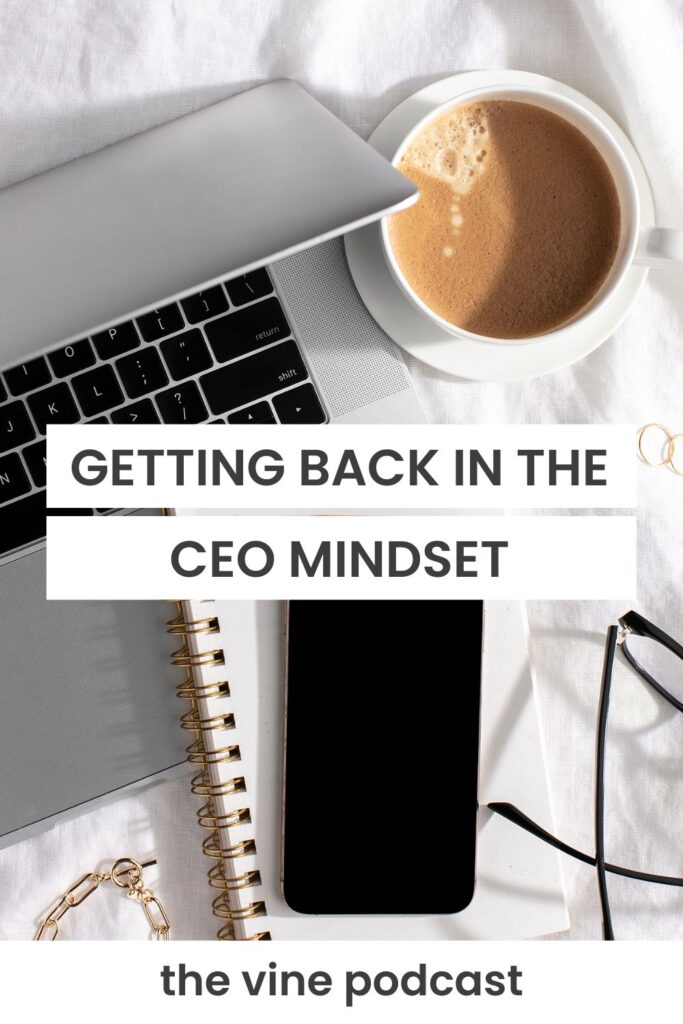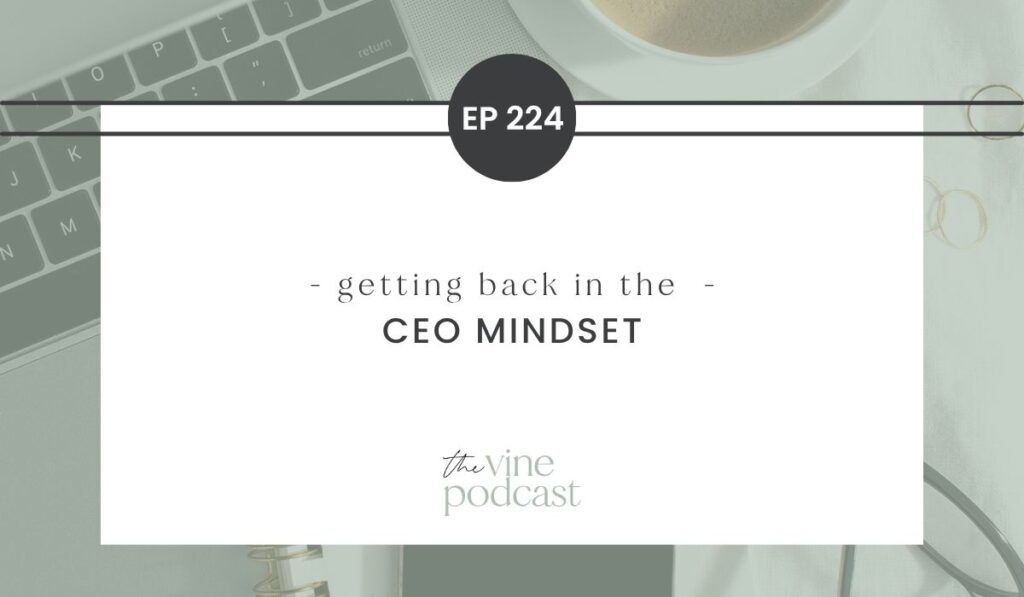Have you ever looked back on the last month—or even the entire year—and wondered why you haven’t achieved as much as you set out to? You’re not alone.
As food bloggers, it’s incredibly easy to slip into an employee mindset without even noticing. We get caught up in the daily grind of creating recipes, editing photos, responding to comments, and checking email. Before we know it, weeks have passed and we’ve made zero progress on our bigger business goals.
The difference between bloggers who feel stuck and those who consistently grow? It comes down to mindset—specifically, whether you’re operating as an employee in your business or as the CEO.
If you’ve been feeling like you’re working harder than ever but not seeing the results you want, this post is for you. Let’s talk about how to recognize when you’ve slipped into employee mode and, more importantly, how to shift back into CEO thinking—especially as we head into the busiest time of year.


The Quote That Changes Everything
There’s a powerful quote that goes something like this: We overestimate what we can accomplish in one day, but we severely underestimate what we can accomplish in a year.
Think about that for a moment. How many times have you started the day with an impossibly long to-do list, only to feel defeated when you couldn’t check off everything? Yet when you look back at what you’ve accomplished over an entire year, you’re often surprised by how much you’ve actually done.
The reason this happens has everything to do with mindset. It’s about how we show up to work in our businesses and whether we’re operating in CEO mindset or employee mindset.
When you can shift into CEO thinking—even while still getting the day-to-day work done—you’ll start seeing real, sustainable growth in your business.
Signs You’ve Slipped Into Employee Mindset
Before we can fix the problem, we need to recognize it. Here are the telltale signs that you’ve been operating in employee mode rather than CEO mode:
You’re constantly reacting instead of being proactive. You spend your days responding to notifications, checking your inbox constantly, and putting out fires rather than working on what you planned.
Your work is mostly administrative or lower-level tasks. When you look back at your week, you realize most of your time was spent on things like scheduling social media posts, responding to comments, or organizing files.
You’re not meeting your goals—or you haven’t set any. You get to the end of the month and realize you made little to no progress on what actually matters. Or worse, you never took the time to set goals in the first place.
You feel like there’s never enough time. Your to-do list keeps growing and growing, and you feel buried under it rather than in control of it.
You’re checking boxes but not making real progress. You’re busy all the time, but when you step back, you realize you’re not actually moving toward your bigger vision.
You haven’t made major changes in years. Even as the industry has changed dramatically around you, your business has stayed essentially the same because you haven’t had the capacity to evolve.
You can’t delegate because “no one can do it as well as you.” You’re constantly creating tasks for team members instead of giving them ownership of their work.
Sound familiar? Don’t worry—recognizing these patterns is the first step toward change.
The Power of Time Tracking
Here’s the uncomfortable truth: it’s nearly impossible to look backward and get a clear picture of where your time has gone. We always see things differently than reality actually was.
You might think you spent “some time” working on your business last week, but when you’re faced with actual data, you might discover you spent zero hours on strategic work and thirty hours on tactical tasks.
That’s why time tracking is crucial.
I use a tool called Toggl (it’s a Chrome browser extension), and I’ve committed to tracking all my time for an entire year. Yes, it takes discipline, but it’s been absolutely invaluable.
If tracking for a full year sounds overwhelming, start with a two-week time audit. But honestly? If you want to spend more time thinking and operating like a CEO, ongoing time tracking is the one thing that will keep you accountable.
How to Set Up Your Time Tracking
Here are the categories I use in Toggl. Think of these as the different departments within your business:
- Admin – Low-level tasks that honestly should probably be delegated
- Business Development – Creating new revenue streams, strategic partnerships, affiliate programs
- CEO Time – Paying invoices, strategic thinking, reflection, planning
- Content Planning – Strategizing what content to create
- Content Updates – Updating old posts, improving existing content
- Digital Products – Working on courses, ebooks, etc.
- Email Marketing – Newsletter writing, sequence creation
- Photography – Recipe shoots and photo editing
- Podcast/Interviews – Guest appearances and your own show
- Team Support – Answering questions, training team members
- Video – Filming and editing
At the end of each week (or the beginning of the following week), review a report of how you spent your time. This gives you an honest, transparent look at where your hours actually went.
Here’s what to look for: If you see zero minutes of CEO time, that’s a red flag. If 75% of your time is spent on photography or content creation with no strategic planning, that’s valuable information.
The simple act of reviewing your time and reflecting on where it went is incredibly undervalued. If you’re constantly moving through tasks at a fast pace without ever slowing down to reflect, you’ll never shift into CEO mindset.

Create a Protected CEO Work Block
Once you’ve started tracking your time and realized you’re not spending enough time on CEO-level work, the next step is to create a protected CEO work block in your calendar.
Here’s the truth: If you don’t have this time carved out and protected, everything else will become more of a priority.
Work will always expand to fill the time you give it. If you don’t set aside and maintain the boundary of CEO time, it simply won’t happen.
For me, Mondays are my protected CEO time. I’m in the Eblog Talk Mastermind, which gives me an hour and a half each Monday for strategic thinking and peer support. I often add time before or after that call to work on my business.
I love that it’s on Mondays specifically because it starts my week off right. I’m not constantly missing it because it happens at the end of the week when I’m exhausted.
Your CEO work block could include:
- Strategic planning for the quarter
- Setting and reviewing goals
- Thinking about where you want your business to be in 6 months or a year
- Planning how to make that vision happen
- Reflecting on what’s working and what’s not
- Learning from resources outside your industry
The Mastermind Advantage
Being in a mastermind has forced me to think at a higher level. Every few weeks, I have a hot seat where I can ask the group a question. This forces me to think strategically because I don’t want to waste that valuable time on something I could figure out with a quick Google search.
I want peer input on real challenges. I want perspectives from people who are running successful businesses and can help me level up.
Having that container forces me to think like a CEO. It surrounds me with people who relate to my struggles but won’t let me wallow—they’ll help me find solutions.
If you’re not in a mastermind, I highly recommend finding one. Whether it’s a paid program or a peer-led group, having that accountability is game-changing.
Managing Your Team Without Getting Sucked Into Employee Work
If you have team members—whether a VA or full-time employees—there’s a delicate balance between supporting them and getting sucked back into employee-level work.
Here’s how to manage your team while staying in CEO mode:
Give them ownership instead of micromanaging. Create systems around what your team does so you’re not responsible for creating work every single day. When your VA asks if you have anything for her to do, use that as an opportunity to create a system for something she can own going forward.
Try to avoid creating one-off tasks. Instead, focus on recurring responsibilities that team members can own completely.
Create a container for team support. If you find yourself constantly being pulled into supporting team members throughout the day, schedule dedicated time for it. Maybe every Tuesday morning, you spend two hours checking in, giving feedback, and answering questions.
This prevents team support from bleeding into your entire week and stealing your energy for CEO-level thinking.
Expand Your Perspective Beyond Food Blogging
The food blogging industry can sometimes feel like an echo chamber. Everyone goes to the same people for advice, follows the same strategies, and thinks about growth in similar ways.
That’s why it’s crucial to expand your perspective outside your industry.
Here’s an example: If you ask another food blogger how to double your revenue, they’ll probably suggest doubling your blog post output. Create more content, get more traffic, earn more income. That’s not bad advice—it’s actually good advice and it’s true.
But if you ask a different type of business owner the same question, they might have completely different ideas. Maybe they’d suggest creating a digital product, building a membership, or developing strategic partnerships.
Hearing stories from other creators and business owners broadens your thinking. It helps you see possibilities you never considered. It helps you think outside the box.
Resources to Expand Your Thinking
Here are a few resources that have helped me think differently:
The Nathan Barry Show – He’s the founder of Kit and interviews six and seven-figure creators (often outside of blogging). His episode with Pat Flynn about YouTube was incredible. I recommend the YouTube channel over the podcast because the visuals add value.
The Graham Cochran Show – His book “Rebel” really expanded my thinking about life and business in ways I didn’t expect.
“10X Is Easier Than 2X” – I’m only 80 pages into this book and it’s already blown my mind. It’s challenging everything I thought was true about business growth.
The point isn’t to abandon food blogging wisdom—it’s to complement it with different perspectives. Be careful not to get stuck in that echo chamber. Expand your thinking about what’s possible.

Your CEO Mindset Challenge
As we wrap up, I want to leave you with some reflection questions. Find that CEO block of time, take yourself to a coffee shop, and really think about these:
Are you truly acting as the CEO of your business? There’s no shame if the answer is no. The important thing is recognizing it and deciding to change.
Are you spending more time working ON your business or IN your business? For most of us, the answer is “in” because we’re creating content, promoting on social media, writing emails—doing tactical, day-to-day things. Those things are important and necessary, but we also need to spend time thinking about the health and future of our businesses.
This Week’s Action Steps
Choose one (or both!) of these challenges:
- Schedule a recurring CEO block in your calendar. Make it something you know you can commit to—whether that’s 30 minutes or two hours. Put a siren emoji next to it. Treat it as your most important appointment of the week.
- Do one thing this week to shift into CEO mindset. Maybe that’s starting a time audit, taking an hour to reflect, or reading something outside your industry. All of these can help you start the shift.
Why This Matters Now More Than Ever
I know Q4 is incredibly busy. There’s so much to do—holiday content to create, recipes to develop, traffic to capitalize on. That’s exactly why this is the most important time to protect your CEO time.
The tasks will always be there. They’re never-ending. But progress only happens when you shift the way you’re thinking and start operating strategically as the CEO of your business.
When you make this shift, you’ll be amazed at what you can accomplish—not in a day, but over the course of a year.
Call to Action
Ready to step into your CEO role? Start by tracking your time for just one week. See where your hours are really going. Then come find me on Instagram @graceandvine and let me know what you discovered. I’d love to continue this conversation with you!
And if you’re ready to invest in your business with strategic branding or website design, I’d love to chat. Head to graceandvinestudios.com to learn more about how we can work together.

ready to take your food blog to the next level?
We work with food bloggers looking to stand out of the crowd through custom brand and website design.




Leave a Comment